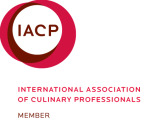Dining Out for Life is this Thursday, March 12, 2009. More than 200 restaurants will donate 25% of their food proceeds to A Loving Spoonful and Friends For Life. I’ll be at the Cascade Room. Where will you dine?
It’s taken me a while, but I’ve figured out the perfect mixture of fats to get a beautiful pie crust.
Shortening is 100% fat and results in unbelievably flaky crusts. Unfortunately, it doesn’t taste very nice. I made a pie with only shortening and found that it left an oily slick on the back of my tongue.
Butter is approximately 35% fat with water suspended in it. It doesn’t give as flaky a crust as shortening, but it sure is tasty. Using only butter, I got a really tasty, but slightly dense pie crust. Also, due to the presence of milk solids and milk sugars in butter, the pie browns a little bit too quickly.
So, the perfect compromise: equal parts shortening and butter.
(FYI: When selecting shortening, read the labels carefully. As evil as Crisco might seem, it contains far less trans fat than some of the so-called “organic” alternatives.)


